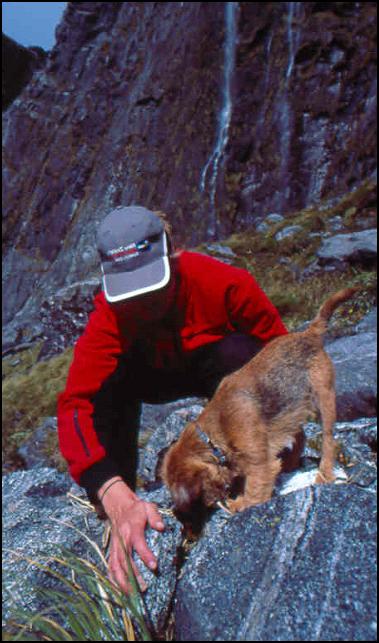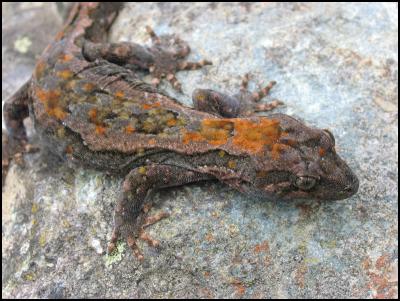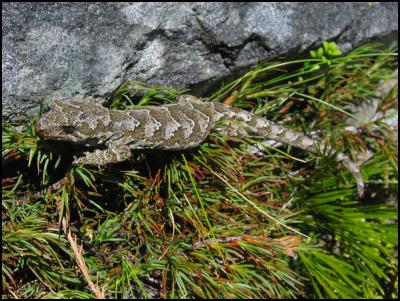Help us find geckos

How DOC staffer Mandy Tocher and her gecko-finding dog, Puti, go about finding these rare geckos. Photo: Tony Jewell.
High Country Enthusiasts We Need Your Help
ROCK CLIMBERS and other high country enthusiasts could again become the heroes of a survey of alpine geckos, designed to discover new species and new localities.
The Department of Conservation, the National Parks and Conservation Foundation and outdoor clothing and equipment retailer Kathmandu have announced the extension of the alpine gecko survey project.
The project has confirmed the existence of a number of new populations of alpine gecko (Hoplodactylus undescribed species). An exciting find was the discovery of the “Cascade” species in the Darran Mountains in Fiordland.
Department of Conservation project manager Andrea Goodman said one of the most wonderful aspects of the survey last year, was the unexpected help from rock climbers.
“Publicity we generated in regard to last summer’s survey really motivated the rock climbing community and five new sightings of these alpine geckos were reported to us,” Ms Goodman said.
“We really hope rock climbers, and perhaps even trampers, can do the same again this year as we extend the scope of the survey to cover most of the South Island alpine zone.”
Ms Goodman said thanks to Kathmandu’s generous sponsorship, a team of lizard experts would be able to follow up on leads from people encountering the animals in the alpine zone over summer. The team would also search alpine habitat it knew to be capable of supporting gecko populations.
“The survey is going to help us determine the conservation status of these animals. We simply don’t know enough about them yet, except for the obvious – that they are difficult to find.”
Last season the DOC team found the first ever nocturnal alpine gecko in Fiordland’s alpine zone with the help of their gecko sniffer dog, Puti.
Ms Goodman said while this had been fantastic, rock climbers had demonstrated their abilities to scope out lizard terrain without any canine assistance. A rock climbing couple from Dunedin had made a sighting after receiving a briefing about the survey and had even managed to take a photograph.
“It is just awesome when people can help us like this,” Ms Goodman said. “We are hoping this season will see even more of a co-operative effort between ourselves and those who enjoy summer in the high country.”
Kathmandu is also producing a coloured “spotters guide” for those who may wish to report sightings as well as two new T-shirts promoting lizard conservation, which will be available from Kathmandu retail outlets around the country.

Click for big version
Photo: Tony Jewell
How you can help with the alpine gecko survey project
The geckos
we are interested in have only very recently been
discovered.
They live in alpine rock bluffs, boulder
piles and screes above 1000m.
They seem to be extremely
rare. They are very variable in colour and pattern, from
drab brownish grey to bold herringbone and chevron patterns,
to the whole animal being virtually covered in blotches of
orange and yellow. All have bright orange colouring inside
the mouth, which distinguishes them from the more common
varieties of gecko.
We would like to receive details of
any unusual sightings of geckos from the mountains. You can
dial 0800-GECKOS or 03 474 6949.
So... If you have seen a gecko in the alpine zone recently or in the distant past, we are keen to know as much as possible:

Click for big version
The "Cascade" gecko, also a species of alpine gecko. It was extremely exciting to find this critter in the Darran Mountains in Fiordland during the initial survey work last season. Photo: Tony Jewell.
When you made your observation.
Details of the location where you found it – both a place name, description of where it was, the altitude, and a map grid reference if possible.
As much detail as you can remember of what the site was like – aspect, amount of rock, type and amount of vegetation.
How you found the gecko, and what it was doing at the time.
What length was it?
What colour was it?
A photograph of the gecko, if you can manage it safely and without disturbing the animal too much.
ENDS


 Bill Bennett: Download Weekly - 100% claim lands One New Zealand in criminal court action
Bill Bennett: Download Weekly - 100% claim lands One New Zealand in criminal court action FSCL: Woman Scammed Out Of $25,000 After Job Offer On LinkedIn
FSCL: Woman Scammed Out Of $25,000 After Job Offer On LinkedIn NIWA: Cheers To Crustaceans - New Species Named After Welly Brewery
NIWA: Cheers To Crustaceans - New Species Named After Welly Brewery MBIE: Trans-Tasman Earth Observation Research Studies Confirmed
MBIE: Trans-Tasman Earth Observation Research Studies Confirmed NZ Association of Scientists: Royal Society Te Apārangi Governance Submissions Close - NZAS Submission
NZ Association of Scientists: Royal Society Te Apārangi Governance Submissions Close - NZAS Submission HortPlus: Project Aims To Improve Quality Of Weather Data In New Zealand
HortPlus: Project Aims To Improve Quality Of Weather Data In New Zealand



